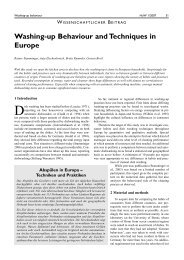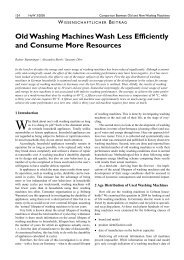Development of a novel mechatronic system for mechanical weed ...
Development of a novel mechatronic system for mechanical weed ...
Development of a novel mechatronic system for mechanical weed ...
Create successful ePaper yourself
Turn your PDF publications into a flip-book with our unique Google optimized e-Paper software.
Materials and methods<br />
48<br />
4.3 Physical prototype <strong>of</strong> the hoeing tool<br />
4.3.1 Selection <strong>of</strong> the drive <strong>for</strong> the hoeing tool<br />
Preferably, a hydro engine <strong>system</strong> would be chosen <strong>for</strong> controlling the hoeing<br />
tool as a tractor implement. Although the hydraulic <strong>system</strong> can fulfil the<br />
requirements, <strong>for</strong> the high accuracy and dynamics expected from the intra-row<br />
<strong>weed</strong>ing tool a hi-pressure servo-hydraulic solution will be necessary. Such a<br />
solution would significantly increase the costs <strong>of</strong> the experiments and after<br />
consideration <strong>of</strong> the required parameters an electrical servo drive able to<br />
provide same per<strong>for</strong>mance like a hydro <strong>system</strong> was choosen.<br />
4.3.1.1 Electrical servo drive<br />
A servo motor, or servo drive, is a <strong>system</strong> which combines a motor with a<br />
controller and positioning device to precisely regulate the speed or position <strong>of</strong> a<br />
load. Such a <strong>system</strong> allows controlling <strong>of</strong> the load, concerning different<br />
parameters such as speed, torque or position or direction. Its basic<br />
components are an interface panel which sends a command signal, a<br />
positioning controller which receives the signal, a servo control amplifier which<br />
provides power to the servo motor, and a feedback device which relays<br />
in<strong>for</strong>mation about position or velocity <strong>of</strong> the motor and load.<br />
The servo can be controlled through semiconductors, such as silicon controller<br />
rectifiers (SCR). Used alone, an SCR is effective but does not provide compete<br />
control (Baldor Electric company 2007). Power from the SCR comes in discrete<br />
pulses, thus instant acceleration and maintaining <strong>of</strong> the steady state are<br />
feasible, but when the motor must be slowed down the SCR can only be turned<br />
<strong>of</strong>f. In such a case there is no direct control <strong>of</strong> the motor and the deceleration <strong>of</strong><br />
the load is affected by inertial <strong>for</strong>ce. With additional electronics a transport delay<br />
in the load response can be introduced to provide more uni<strong>for</strong>m speed changes,<br />
but this <strong>of</strong>ten introduces too much <strong>system</strong> inertia and is not suitable <strong>for</strong><br />
applications requiring rapid modification <strong>of</strong> the speed. Transistors can be used<br />
to create a more linear power response which is delivered constantly rather<br />
than in discrete pulses like the SCR alone. Other techniques exist as well,<br />
including pulse width modulation (PWM) and pulse frequency modulation





